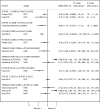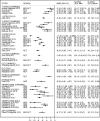Minimally-invasive glaucoma surgeries (MIGS) for open angle glaucoma: A systematic review and meta-analysis
- PMID: 28850575
- PMCID: PMC5574616
- DOI: 10.1371/journal.pone.0183142
Minimally-invasive glaucoma surgeries (MIGS) for open angle glaucoma: A systematic review and meta-analysis
Abstract
Background: MIGS have been developed as a surgical alternative for glaucomatous patients.
Purpose: To analyze the change in intraocular pressure (IOP) and glaucoma medications using different MIGS devices (Trabectome, iStent, Excimer Laser Trabeculotomy (ELT), iStent Supra, CyPass, XEN, Hydrus, Fugo Blade, Ab interno canaloplasty, Goniscopy-assisted transluminal trabeculotomy) as a solo procedure or in association with phacoemulsification.
Methods: Randomized control trials (RCT) and non-RCT (non randomized comparative studies, NRS, and before-after studies) were included. Studies with at least one year of follow-up in patients affected by primary open angle glaucoma, pseudoexfoliative glaucoma or pigmentary glaucoma were considered. Risk of Bias assessment was performed using the Cochrane Risk of Bias and the ROBINS-I tools. The main outcome was the effect of MIGS devices compared to medical therapy, cataract surgery, other glaucoma surgeries and other MIGS on both IOP and use of glaucoma medications 12 months after surgery. Outcomes measures were the mean difference in the change of IOP and glaucoma medication compared to baseline at one and two years and all ocular adverse events. The current meta-analysis is registered on PROSPERO (reference n° CRD42016037280).
Results: Over a total of 3,069 studies, nine RCT and 21 case series with a total of 2.928 eyes were included. Main concerns about risk of bias in RCTs were lack of blinding, allocation concealment and attrition bias while in non-RCTs they were represented by patients' selection, masking of participants and co-intervention management. Limited evidence was found based on both RCTs and non RCTs that compared MIGS surgery with medical therapy or other MIGS. In before-after series, MIGS surgery seemed effective in lowering both IOP and glaucoma drug use. MIGS showed a good safety profile: IOP spikes were the most frequent complications and no cases of infection or BCVA loss due to glaucoma were reported.
Conclusions: Although MIGS seem efficient in the reduction of the IOP and glaucoma medication and show good safety profile, this evidence is mainly derived from non-comparative studies and further, good quality RCTs are warranted.
Conflict of interest statement
Figures





References
-
- Quigley HA, Broman AT. The number of people with glaucoma worldwide in 2010 and 2020. Br J Ophthalmol. 2006;90(3):262–267. doi: 10.1136/bjo.2005.081224 - DOI - PMC - PubMed
-
- European Glaucoma Society. Terminology and guidelines for glaucoma 4th edition Savona, Italy: Editrice PubliComm, 2014.
-
- Schwartz GF, Quigley HA. Adherence and persistence with glaucoma therapy. Surv Ophthalmol. 2008;53 Suppl1:S57–68. - PubMed
-
- Schuman JS. Antiglaucoma medications: a review of safety and tolerability issues related to their use. Clin Ther. 2000;22(2):167–208. doi: 10.1016/S0149-2918(00)88478-7 - DOI - PubMed
Publication types
MeSH terms
LinkOut - more resources
Full Text Sources
Other Literature Sources
Medical

